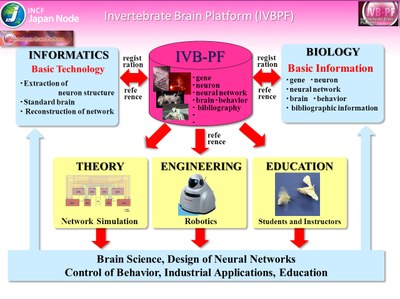Development and application of the Invertebrate Brain Platform (IVB-PF)
Akira Takashima (Research Center for Advanced Science and Technology, the University of Tokyo, Japan), Tomoki Kazawa (Research Center for Advanced Science and Technology, the University of Tokyo, Japan), Shigehiro Namiki (Research Center for Advanced Science and Technology, the University of Tokyo, Japan), S Shuichi Haupt (Research Center for Advanced Science and Technology, the University of Tokyo, Japan), Hidetoshi Ikeno (University of Hyogo), Ryohei Kanzaki (Research Center for Advanced Science and Technology, the University of Tokyo, Japan), Shiro Usui (RIKEN Brain Science Institute)
Invertebrate brains are excellent model systems for analyzing the structure and function of nervous systems providing a wide range of levels complexity, in particular in the organization of their brains. Especially arthropods are of interest showing rich behavioral repertoires despite relatively simple nervous systems. For a systematic approach to understand neuronal mechanisms generating animal behavior, it is important to integrate research results and resources from various fields, from morphology, physiology, pharmacology, and molecular biology of single neurons to behavioral studies. Consolidation, sharing methods and information about different species of invertebrates, as well as research tools, mathematical models, and documents could provide a concise overview over the current state of the art in behavioral neuroscience.
The Invertebrate Brain Platform (IVB-PF; http://invbrain.neuroinf.jp) project organized by the J-Node of the INCF has been initiated due to these needs that are more pressing than ever at the pace new data are being obtained nowadays. IVB-PF comprises databases for representative invertebrate species, such as silkmoth, honeybee, cricket, cockroach, flies, and crayfish, ranging from the physiology and morphology of individual neurons to the general structure of the central nervous systems. It also provides a variety of images and movies of whole brains of invertebrates and their characteristic behaviors. Among the information currently available are: images of brains of 52 species from 6 phyla, 474 individual neuron data sets from silkmoth, 34 movies of arthropod behavior, several manuals for physiological and behavioral experiments, and introductions to invertebrate nervous systems and behavior. In addition, we provide a comparative overview over the representative invertebrate behaviors, sensory organs, and the structure and function of the central nervous systems in tabular form that is linked to the relevant databases in IVB-PF and external locations. The users can browse and compare invertebrate behaviors, sensory organs, and the structure and function of the central nervous systems across species through our tabulated interface to easily extract relevant information on these invertebrate species for research and development.
Both databases and data analysis environments are provided with the goal to promote interdisciplinary interactions between various fields including neuroscience, information science, and engineering that are necessary for advances in our understanding of neural systems (Fig.2). The IVB-PF is an integral part of a system of platforms initiated by the J-Node of INCF to allow efficient access to information covering all fields of neuroscience for education, research, and development.


 Latest news for Neuroinformatics 2011
Latest news for Neuroinformatics 2011 Follow INCF on Twitter
Follow INCF on Twitter
